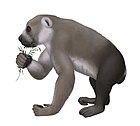Angwantibo
| Golden pottos[1] | |
|---|---|

| |
| Calabar angwantibo, Arctocebus calabarensis | |
| Scientific classification | |
| Domain: | Eukaryota |
| Kingdom: | Animalia |
| Phylum: | Chordata |
| Class: | Mammalia |
| Order: | Primates |
| Suborder: | Strepsirrhini |
| Family: | Lorisidae |
| Subfamily: | Perodicticinae |
| Genus: | Arctocebus J. E. Gray, 1863 |
| Type species | |
| Perodicticus calabarensis J. A. Smith, 1860
| |
| Species | |
Angwantibos are two species of strepsirrhine primates classified in the genus Arctocebus of the family Lorisidae. They are also known as golden pottos because of their yellow or golden coloration.
Angwantibos live in tropical Africa and their range includes Nigeria, Cameroon north of the Democratic Republic of Congo.
Angwantibos grow to a size of 22 to 30 cm, and have almost no tail at all. They only weigh up to 0.5 kg. Their fur is yellow brown to golden in color. Their snout is more pointed than that of the other lorids and this, along with their round ears, gives it the bear-like appearance that lends them their name in German: Bärenmaki, "bear lemur".
Solitary, nocturnal and arboreal, they prefer the underbrush and the lower layers of the forests. They spend the day hidden in the leaves. Like all lorisids they are characterized by slow movements.
The diet of angwantibos consists predominantly of insects (mostly caterpillars), and occasionally fruits. Owing to their careful movements and their good sense of smell, they can quietly stalk and close-in on their prey and catch it with a lightning-quick movement.
The males mate with all available females whose territory overlaps with theirs.[citation needed] Copulation takes place hanging onto a branch.[2] Gestation lasts 130 days and births are of a single offspring. The juvenile clasps itself first to the belly of the mother and later she may park her offspring on a branch while she goes searching for food. Within three to four months the young are weaned, at about six months it leaves its mother, and at an age of eight to ten months it becomes fully mature. The life expectancy of angwantibos is at most 13 years.[citation needed]
A subplot in Gerald Durrell's first book The Overloaded Ark centres on his attempts to secure an angwantibo for zoological study.
Species
[edit]| Common name | Scientific name and subspecies | Range | Size and ecology | IUCN status and estimated population |
|---|---|---|---|---|
| Calabar angwantibo | A. calabarensis (J. A. Smith, 1860) |
Western equatorial Africa
|
Size: 22–31 cm (9–12 in) long, plus 4–10 cm (2–4 in) tail[3] Habitat: Forest[4] Diet: Insects, as well as fruit and gum[3] |
NT
|
| Golden angwantibo
|
A. aureus de Winton, 1902 |
Western equatorial Africa
|
Size: 22–26 cm (9–10 in) long, plus vestigial tail[5] Habitat: Forest[6] Diet: Insects and fruit[6] |
LC
|
References
[edit]- ^ Groves, C. P. (2005). Wilson, D. E.; Reeder, D. M. (eds.). Mammal Species of the World: A Taxonomic and Geographic Reference (3rd ed.). Baltimore: Johns Hopkins University Press. pp. 121–122. ISBN 0-801-88221-4. OCLC 62265494.
- ^ Dixson, Alan F. (2012-01-26). Primate Sexuality: Comparative Studies of the Prosimians, Monkeys, Apes, and Humans. OUP Oxford. ISBN 978-0-19-150342-9.
- ^ a b Olson, Taryn (2003). "Arctocebus calabarensis". Animal Diversity Web. University of Michigan. Retrieved June 25, 2023.
- ^ a b Oates, J. F.; Svensson, M. (2019). "Arctocebus calabarensis". IUCN Red List of Threatened Species. 2019: e.T2054A17969996. doi:10.2305/IUCN.UK.2019-1.RLTS.T2054A17969996.en.
- ^ Kingdon, ch. Lorisids
- ^ a b c Svensson, M.; Nekaris, K. A. I. (2019). "Arctocebus aureus". IUCN Red List of Threatened Species. 2019: e.T2053A17969875. doi:10.2305/IUCN.UK.2019-3.RLTS.T2053A17969875.en.
Sources
[edit]- Kingdon, Jonathan (2020). The Kingdon Pocket Guide to African Mammals (2nd ed.). Bloomsbury Publishing. ISBN 978-1-4729-8320-6.



